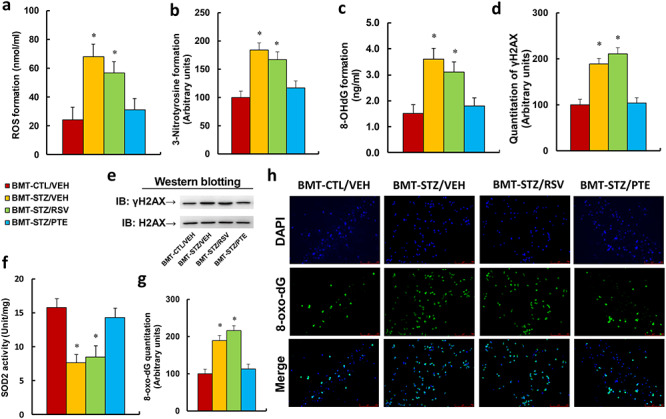Figure 3.

BMT of PTE-treated diabetic HSCs protects against diabetes-induced oxidative stress in PBMCs. Experimental rats were randomly separated into 4 groups as follows: rats with BMT of HSCs from CTL/VEH (BMT-CTL/VEH); rats with BMT of HSCs from STZ/VEH (BMT-STZ/VEH); rats with BMT of HSCs from STZ/RSV (BMT-STZ/RSV); and rats with BMT of HSCs from STZ/PTE (BMT-STZ/PTE). The rats were subjected to a model of cutaneous burn injury and PBMCs were collected for biomedical analysis after a 3-week period post-burn. (a) ROS formation in PBMCs, n = 5. (b) Quantitation of 3-nitrotyrosine formation, n = 5. (c) 8-OHdG formation, n = 5. (d) Quantitation of γH2AX formation. (e) Representative γH2AX western blotting band for (d), n = 5. (f) SOD2 activity, n = 5. (g) Quantitation of 8-oxo-dG formation, n = 5. (h) Representative pictures of 8-oxo-dG staining for oxidative stress (green) and DAPI staining for nuclei (blue) in PBMC, n = 4. For bars in graphs marked with an asterisk, p < 0.05 vs BMT-CTL/VEH group. Data are expressed as mean ± SEM. BMT bone marrow transplantation, PTE pterostilbene, HSCs hematopoietic stem cells, PBMCs peripheral blood mononuclear cells, CTL control, VEH vehicle, STZ streptozotocin, RSV resveratrol, ROS reactive oxygen species, OHdG 8-hydroxy-2′-deoxyguanosine, γH2AX phospho-Ser139 histone H2A.X, SOD2 superoxide dismutase 2, DAPI 4,6-diamidino-2-phenylindole, H2AX H2A.X Variant Histone, 8-oxo-dG 8-Oxo-2′-deoxyguanosine
